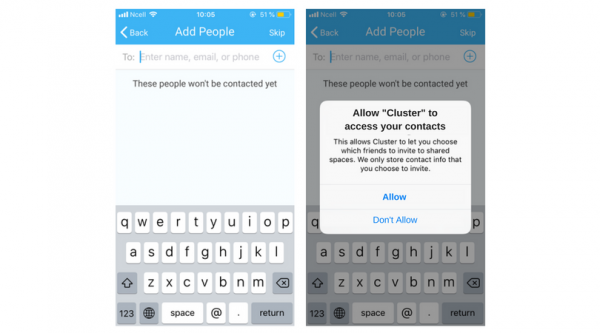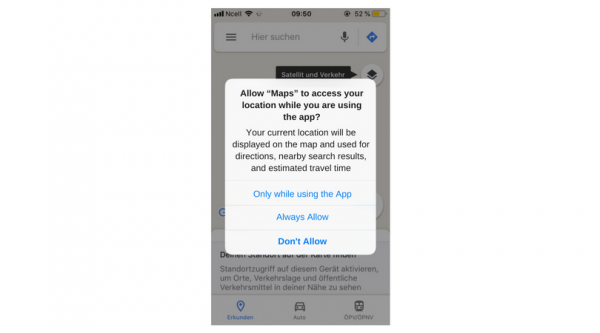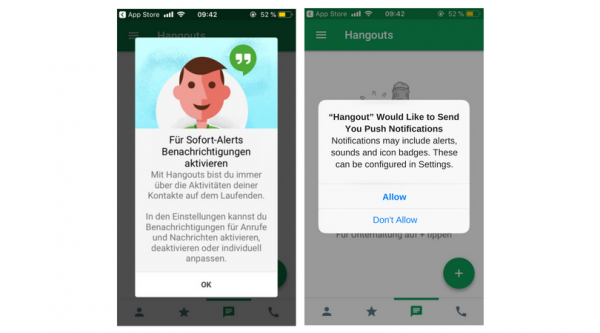App Permission Request Guide: How to Stop Losing Users
PUBLISHED
11 February, 2021

Content Manager

Hey, you.
Allow us to access your location, phone contacts and photos to read this article.
We won’t tell you why we need this information.
Please click on “Allow” now.
Okay, this is exaggerated, but sometimes it feels like this when apps ask for permissions. Right?
You only have one chance to send out an app permission request. To increase your success rate while asking, for example, for the push notification opt-in, you have to make two important decisions: when to ask your user and how to ask them.

Image credit: Material Design
When To Send Out the App Permission Request
You can ask your users at two different points of the app usage: at the beginning — when they open the app for the first time — or in context at a specific point when you need the permissions.
Keep in mind: Decide whether app permission is absolutely necessary to use your app or if it can be required later. Is the app useless when you don’t have permission since the first usage?
Ask Upfront
Critical permissions should be asked upfront. Critical app permissions are understood to be the ones that you definitely need so you can offer your users the best user experience.
Getting or not getting this permission will change the entire user experience.
If you have an app which depends on the location of the users, declining the location permission can render the app useless. Make sure that they understand what your app does and why you need this permission.
You shouldn’t overwhelm your users with a series of app permission requests when starting the app for the first time. This might work if the users are familiar with your app and know the benefits they get from accepting.
If not, it’s likely that they won’t accept it. Moreover, you lose the chance to ask them again for permission.
Ask in Context
Your users will feel overwhelmed when you ask them for permissions if they don’t understand the importance of these. Uncritical permissions should be asked for in context. Tell your users why you need permission and what value they get.
Users are more likely to agree to app permissions when they get asked during important tasks where permission is needed.
How T o Send Out the App Permission Request
After deciding when to ask your users for permission, you can start to design your permission request.
Here you have to look at how clear the importance of your app permission request is. Does the user understand why you need the permission or do you have to explain the importance and value?
You can decide between an educational or a noneducational request.
Keep in mind: Don’t expect your users to understand why it’s important and valuable to accept the app permission request on the first view.
Noneducational Requests
Wait for a User Action
This matches with “asking in context.”
If you want to make sure that your users know exactly why you need the permission and what value they get from giving it to you, you should wait for a user action.
When you ask them after the user requests an action, they’ll understand why you need this permission.
Moreover, they’ll understand that the app can’t fulfill the request without their permission.

Screenshot from the Cluster mobile app
Educational App Permission Requests
Add Some Informational Words
You shouldn’t use the default request text. It doesn’t tell the users anything about why it’s important to get their permission.
During the onboarding process, users get confronted with a lot of requests and fields they have to fill out. They can’t possibly understand why they have to give you several permissions unless you explain it to them.
Add some informational words to the request, explain the value and build up trust.

Screenshot from the Google Maps mobile app
Ask Twice
You only have one chance to ask your users for permission. If you do it wrong — or at the wrong time — you lose the chance to ask them again.
To avoid this, you can use a simple trick. Show your users a fake request in advance. If they accept it, show them the real one. There are two benefits to this trick:
The fake request screen can include some educational information and describe to your users why it’s important to accept the request and what benefits they get.
If your users decide against accepting the permission, you will not lose your chance to ask again. You can wait for a more appropriate time to ask again.

Screenshot from the Hangouts mobile app
Be Transparent
Be clear about what permissions you access and why you need them.
Offer your users this information and let them make informed decisions. Provide them all the important information about the what and why.
Rejected App Permission Request? Don’t Give Up!
Well, I told you that you only have one chance to ask your user for their permission. The statement stands, but there’s still hope.
If the user has denied the permission and changes their opinion afterwards, they have to go a long and complicated way through the settings to find how to fix the issue. This is your other one chance to get the permission.
If they request something where the app needs permission they have denied before, you can ask the user again.
You can’t send them the permission request again, but you can send an own request and link to the right page in the settings. This saves users time — and frustration — to find this setting on their own.
Conclusion
Don’t expect your users to understand the importance and value behind every app permission request.
Users don’t think about this and simply want to save their personal data. Think about two important questions:
Do you want to ask your user upfront or in context?
Do you have to educate your user about the value of the permission or is this clear?
Choose the right moment and the right educational level to ask them. Give them the feeling they can trust you and ensure that your users understand what value they get from giving you their permission.
Now go out and get those permissions!
To continue improving your app’s UX, start using UXCam now.
Related Articles:
AUTHOR

Annemarie Bufe
Content Manager
Passionate hobby dancer. Working at UXCam.
What’s UXCam?
Related articles
Product best practices
App Onboarding Guide: Top 10 Onboarding Flow Examples 2025
Take a look at 10 examples of mobile apps that get user onboarding flows right. Get inspired by proven app onboarding approaches and improve your...

Jonas Kurzweg
Growth Lead
Product best practices
Como Encontrar Usuários Ativos De Um Aplicativo
Descubra estratégias comprovadas para identificar e engajar usuários ativos do seu app, aumentar a retenção, impulsionar o crescimento e maximizar o sucesso do seu...

Tope Longe
Growth Marketing Manager
Product best practices
Product Performance Analysis - A 7-Step Playbook with UXCam
Learn how to use product performance analysis to improve UX, boost retention, and drive growth with actionable steps and...

Tope Longe
Growth Marketing Manager
